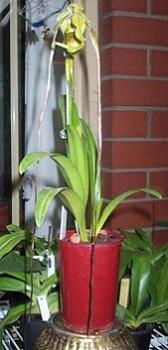

Phragmipedium caudatum var. exstaminodium (Castano, Hagsater, & Aguirre) <combination never made>
- Described: Castano, Hagsater, & Aguirre in Orquidea (Mexico) 9(29): 19 (1984)
- Transferred: <never made>
- Etymology: Name derived from the bloom's most distinctive morphological feature, its missing staminode.
- Varieties & Forms: none
- Synonyms: none
- Chromosome Count: unknown
Plant Habit
- Leaves: up to 45 cm long, ~ 4 cm wide, plain green
- Inflorescence: 2-3 flowered, up to 50 cm long, peduncle green, finely pubescent
- Bloom: staminode absent, autogamous, otherwise similar to Phrag. caudatum var. warscewiczianum

- Plant:

Habitat Data
- Distribution: found only in Chiapas, Mexico

- Elevation: 1350-1700 m
- Peak Flowering in the Wild: May-July
- Ecology: wet oak-conifer forest
- Mean Temperature Range: 16-21°C
- Light: moderate shade
- Medium: found clinging to the bark of trees 1-4 m above the ground
- Water: constant moisture
Notes:
- At some point during bud development or anthesis, the pollenia come in contact with the stigmatic surface, causing the blooms to self-pollinate.
Sources:
- Dressler, R.L. "La Chinela, Alive & Well in Western Panama: Notes on the Panamanian Long-Tailed Phragmipedium." Orchid Digest 69, no. 2 (Apr/Jun 2005): 86-91.
- McCook, Lucile M. "Systematics of Phragmipedium (Cypripedioideae; Orchidaceae)," Ph.D. dissertation, Cornell University, 1989.
Primary Hybrids
| Phrag. exstaminodium x |
Hybrid |
| caudatum |
Memoria Julius Dixler (2006) |
Return to the Data Sheets Page
Page Created By: Stephen Manza
Last Updated: 9-29-06
contact: silence882@gmail.com





